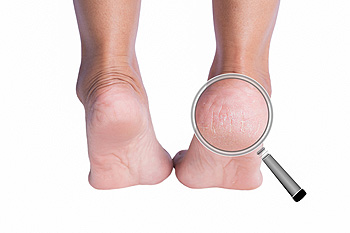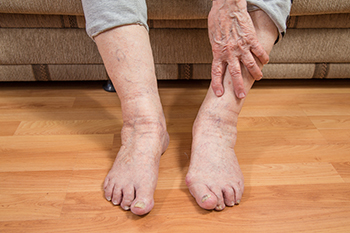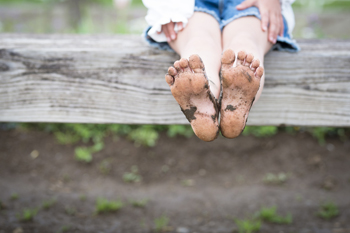Items filtered by date: November 2022
Cracked Heels and Socks

Although many cases of cracked heels are not necessarily severe and painful, the condition can nonetheless be an annoyance and potentially uncomfortable. The condition is defined as a lack of moisture on the back of the heels that causes the skin to crack and fissure. There are many ways in which cracked heels might be prevented. Socks might play an important role in achieving this end. For example, to prevent the heels from becoming dry, an individual could generously apply moisturizer to the feet at night before bed and put on a pair of socks. The socks can essentially lock in the moisturizer and help improve the extent to which the moisturizer is absorbed by the feet. If you are worried about cracked heels and want to learn more preventative methods, contact a podiatrist today. This foot specialist can help you address any problems you might have.
Cracked heels are unsightly and can cause further damage to your shoes and feet. If you have any concerns, contact Dan Kirk, DPM from Bluffton Foot & Ankle. Our doctor can provide the care you need to keep you pain-free and on your feet.
Cracked Heels
Cracked heels appear unappealing and can make it harder for you walk around in sandals. Aside from looking unpleasant, cracked heels can also tear stockings, socks, and wear out your shoes. There are several methods to help restore a cracked heel and prevent further damage.
How Do You Get Them?
Dry skin is the number one culprit in creating cracked heels. Many athletes, walkers, joggers, and even swimmers suffer from cracked heels. Age and skin oil production play a role to getting cracked heels as well.
Promote Healing
Over the counter medicines can help, especially for those that need instant relief or who suffer from chronic dry feet.
Wear Socks – Wearing socks with medicated creams helps lock in moisture.
Moisturizers – Applying both day and night will help alleviate dryness which causes cracking.
Pumice Stones – These exfoliate and remove dead skin, which allows for smoother moisturizer application and better absorption into the skin.
Change in Diet
Eating healthy with a well-balanced diet will give the skin a fresh and radiant look. Your body responds to the kinds of food you ingest. Omega-3 fatty acids and zinc supplements can also revitalize skin tissue.
Most importantly, seek professional help if unsure how to proceed in treating cracked heels. A podiatrist will help you with any questions or information needed.
If you have any questions, please feel free to contact our offices located in Bluffton and Celina, OH . We offer the newest diagnostic and treatment technologies for all your foot care needs.
What Are the Symptoms of Athlete’s Foot?

One of the most unsightly and aggravating foot conditions is known as athlete’s foot. In addition to this, it is regarded as being contagious, and it is beneficial to wear appropriate shoes while in certain areas. These environments can include public swimming pools, shower room floors, and locker rooms. Additionally, it is important to refrain from sharing shoes, socks, and towels. It is a fungal infection that invades the skin on the feet through small cuts. Common symptoms that many people experience can include itchiness, redness, and in severe cases, small blisters may develop. It can be uncomfortable between the toes, and many people seek medical attention that can provide relief. Additional symptoms can consist of thicker skin on the bottom of the feet, and the skin may become scaly and perhaps peel. A visit to a podiatrist is often necessary, and this medical professional can properly diagnose and effectively treat athlete's foot.
Athlete’s foot is an inconvenient condition that can be easily reduced with the proper treatment. If you have any concerns about your feet and ankles, contact Dan Kirk, DPM from Bluffton Foot & Ankle. Our doctor will treat your foot and ankle needs.
Athlete’s Foot: The Sole Story
Athlete's foot, also known as tinea pedis, can be an extremely contagious foot infection. It is commonly contracted in public changing areas and bathrooms, dormitory style living quarters, around locker rooms and public swimming pools, or anywhere your feet often come into contact with other people.
Solutions to Combat Athlete’s Foot
- Hydrate your feet by using lotion
- Exfoliate
- Buff off nails
- Use of anti-fungal products
- Examine your feet and visit your doctor if any suspicious blisters or cuts develop
Athlete’s foot can cause many irritating symptoms such as dry and flaking skin, itching, and redness. Some more severe symptoms can include bleeding and cracked skin, intense itching and burning, and even pain when walking. In the worst cases, Athlete’s foot can cause blistering as well. Speak to your podiatrist for a better understanding of the different causes of Athlete’s foot, as well as help in determining which treatment options are best for you.
If you have any questions please feel free to contact our offices located in Bluffton and Celina, OH . We offer the newest diagnostic and treatment technologies for all your foot and ankle needs.
Can You Train With Sever’s Disease?

Sever’s disease is a foot condition characterized by a particular kind of heel pain. Commonly occurring in children, Sever’s disease is triggered by the inflammation of the growth plate. Many individuals with Sever’s disease will want to continue engaging in physical activity despite having this condition. Each patient is different and will require unique treatment plans. Generally, however, someone with Sever’s disease can consider switching to a physical activity that is lower-impact, such as cycling or swimming. Additionally, someone with a less severe case of Sever’s disease might consider being more selective about the training activities in which they engage. For example, if an individual is training for football, they might think about participating in activities that do not exacerbate heel pain and substituting others with more low-impact activities. As always, it is best to be cautious. Contact a podiatrist today for more information.
Sever's disease often occurs in children and teens. If your child is experiencing foot or ankle pain, see Dan Kirk, DPM from Bluffton Foot & Ankle. Our doctor can treat your child’s foot and ankle needs.
Sever’s Disease
Sever’s disease is also known as calcaneal apophysitis, which is a medical condition that causes heel pain I none or both feet. The disease is known to affect children between the ages of 8 and 14.
Sever’s disease occurs when part of the child’s heel known as the growth plate (calcaneal epiphysis) is attached to the Achilles tendon. This area can suffer injury when the muscles and tendons of the growing foot do not keep pace with bone growth. Therefore, the constant pain which one experiences at the back of the heel will make the child unable to put any weight on the heel. The child is then forced to walk on their toes.
Symptoms
Acute pain – Pain associated with Sever’s disease is usually felt in the heel when the child engages in physical activity such as walking, jumping and or running.
Highly active – Children who are very active are among the most susceptible in experiencing Sever’s disease, because of the stress and tension placed on their feet.
If you have any questions, please feel free to contact our offices located in Bluffton and Celina, OH . We offer the newest diagnostic and treatment technologies for all your foot and ankle injuries.
The Feet May Change Shape as Aging Occurs

Elderly patients may find that life is easier when attention is paid to their feet. The shape of the feet can change as the aging process occurs, and balance and range of motion may also be affected. Seniors' feet may flatten or become wide. Injuries may happen to the bones and joints as the fatty padding wears down. It is wise to practice elderly foot care tips, and the first step to implement is washing and drying the feet, followed by applying a good moisturizer. Foot conditions like ingrown toenails may be avoided when the nails are trimmed straight across and not too short. Some patients develop bed sores on their feet from resting them on a pillow for extended periods. This can be alleviated by lifting the ankles away from the pillow. Additional methods can be implemented to practice proper foot care, and it is suggested that a podiatrist is contacted who can offer guidance.
Proper foot care is something many older adults forget to consider. If you have any concerns about your feet and ankles, contact Dan Kirk, DPM from Bluffton Foot & Ankle. Our doctor can provide the care you need to keep you pain-free and on your feet.
The Elderly and Their Feet
As we age we start to notice many changes in our body, but the elder population may not notice them right away. Medical conditions may prevent the elderly to take notice of their foot health right away. Poor vision is a lead contributor to not taking action for the elderly.
Common Conditions
- Neuropathy – can reduce feeling in the feet and can hide many life-threatening medical conditions.
- Reduced flexibility – prevents the ability of proper toenail trimming, and foot cleaning. If left untreated, it may lead to further medical issues.
- Foot sores – amongst the older population can be serious before they are discovered. Some of the problematic conditions they may face are:
- Gouging toenails affecting nearby toe
- Shoes that don’t fit properly
- Pressure sores
- Loss of circulation in legs & feet
- Edema & swelling of feet and ankles
Susceptible Infections
Diabetes and poor circulation can cause general loss of sensitivity over the years, turning a simple cut into a serious issue.
If you have any questions please feel free to contact our offices located in Bluffton and Celina, OH . We offer the newest diagnostic and treatment technologies for all your foot and ankle needs.
Do You Suffer From Painful Feet?
Causes of Heel Pain in Kids

Heel pain in children is usually not serious or lasting. If a child complains of such pain, has tenderness in the back of their foot or ankle, or is limping or walking on their toes, they may be suffering from one of several conditions. A few common causes of heel pain in children are Sever’s disease, Achilles tendinitis, and plantar fasciitis. Sever’s disease can cause heel pain in children who participate in sports and are between 5 and 11 years of age. Experts believe it develops from the pull of the Achilles tendon on the still growing heel bone. Achilles tendinitis, where the Achilles tendon gets inflamed, might be the culprit of heel pain, particularly if the child has a sudden increase in repetitive activity. Plantar fasciitis is also an overuse injury that involves irritation of the plantar fascia, the thick band of connective tissue that runs along the arch from the heel to the toes. It is usually worse in the morning and improves as the day wears on. These kinds of injuries typically resolve with rest. However, it is important to see a podiatrist if your child complains of heel or foot pain in order to get a proper diagnosis and treatment plan.
Making sure that your children maintain good foot health is very important as they grow. If you have any questions, contact Dan Kirk, DPM of Bluffton Foot & Ankle. Our doctor can provide the care you need to keep you pain-free and on your feet.
Keeping Children's Feet Healthy
Having healthy feet during childhood can help prevent medical problems later in life, namely in the back and legs. As children grow, their feet require different types of care. Here are some things to consider...
Although babies do not walk yet, it is still very important to take care of their feet.
Avoid putting tight shoes or socks on his or her feet.
Allow the baby to stretch and kick his or her feet to feel comfortable.
As a toddler, kids are now on the move and begin to develop differently. At this age, toddlers are getting a feel for walking, so don’t be alarmed if your toddler is unsteady or ‘walks funny’.
As your child gets older, it is important to teach them how to take care of their feet.
Show them proper hygiene to prevent infections such as fungus.
Be watchful for any pain or injury.
Have all injuries checked by a doctor as soon as possible.
Comfortable, protective shoes should always be worn, especially at play.
If you have any questions please feel free to contact our offices located in Bluffton and Celina, OH . We offer the newest diagnostic and treatment technologies for all your foot and ankle needs.

